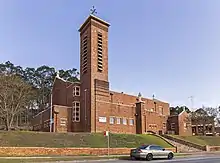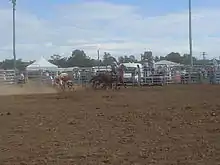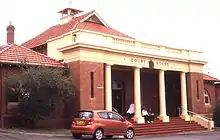| Cessnock New South Wales | |||||||||
|---|---|---|---|---|---|---|---|---|---|
.jpg.webp) Vincent Street, the main street of Cessnock | |||||||||
 Cessnock | |||||||||
| Coordinates | 32°50′3″S 151°21′19.8″E / 32.83417°S 151.355500°E | ||||||||
| Population | 23,211 (UCL 2021)[1] | ||||||||
| Postcode(s) | 2325 | ||||||||
| Elevation | 80 m (262 ft) | ||||||||
| Time zone | AEST (UTC+10) | ||||||||
| • Summer (DST) | AEDT (UTC+11) | ||||||||
| Location | |||||||||
| LGA(s) | City of Cessnock | ||||||||
| Region | Hunter | ||||||||
| County | Northumberland | ||||||||
| Parish | Cessnock | ||||||||
| State electorate(s) | |||||||||
| Federal division(s) | Hunter | ||||||||
| |||||||||
Cessnock is a city in the Hunter Valley of New South Wales, Australia, about 52 km (32 mi) by road west of Newcastle. It is the administrative centre of the City of Cessnock LGA and was named after an 1826 grant of land called Cessnock Estate, which was owned by John Campbell.[2][3] The local area was once known as "The Coalfields", and it is the gateway city to the vineyards of the Hunter Valley, which includes Pokolbin, Mount View, Lovedale, Broke, Rothbury, and Branxton.
History
The Wonnarua people are the Traditional Owners of the Cessnock area. Many were killed or died as a result of European diseases after colonisation. Others were forced onto neighbouring tribal territory and killed. The city of Cessnock features many Indigenous place names including Congewai, Kurri Kurri, Laguna, Nulkaba and Wollombi.[4][5]
Lying between Australia's earliest European settlements – Sydney, the Hawkesbury River and Newcastle, pastoralists commenced settlement of the land in the 1820s. Cessnock was named by Scottish settler John Campbell, after his grandfather's baronial Cessnock Castle in Galston, East Ayrshire, to reflect the aristocratic heritage and ambitions for this estate.[2][3] The township of Cessnock developed from 1850, as a service centre at the junction of the Great North Road from Sydney to the Hunter Valley, with branches to Maitland and Singleton.
The establishment of the South Maitland coalfields generated extensive land settlement between 1903 and 1923. The current pattern of urban development, transport routes and industrial landscape was laid at this time. The surveying of the Greta coal seam by Professor Edgeworth David around 1888[6] became the impetus for considerable social and economic change in the area with the development of the coal mining industry.[7]
Demographics

According to the 2016 census of Population, there were 21,725 people in the Cessnock urban centre.
- Aboriginal and Torres Strait Islander people made up 8.2% of the population.
- 86.8% of people were born in Australia. The next most common countries of birth were England 1.6%, New Zealand 0.9% and Scotland 0.5%.
- 88.3% of people spoke only English at home.
- The most common responses for religion were Anglican 27.5%, No Religion 24.6% and Catholic 18.9%.[8]
Economy
.jpg.webp)
The decline of mining on the South Maitland Coalfields has been paralleled by growth in the wine industry and better access to other employment centres.
The Hunter Valley wine-growing area near Cessnock is Australia's oldest wine region and one of the most famous, with around 1,800 hectares (4,448 acres) under vine. The vineyards of Pokolbin, Mount View and Allandale, with their rich volcanic soils tended by entrepreneurial vignerons, are also the focus of a thriving and growing tourism industry. The extension and eventual completion of the F3 Freeway, created a property and tourism boom during the 1990s.
Cessnock has begun to develop other tourist ventures beyond the wine industry such as championship golf courses, hot air ballooning,[9] sky-diving, and guest house accommodation.
The city council has actively pursued a policy of urban renewal in the city centre since 2001. The local council was one of the first to introduce a recycling program for waste disposal in the state.
Most employment comes from the local port city of Newcastle, the nearby major centres of Maitland and Singleton and in service industries in the local council area, which comprises many small towns, such as Kurri Kurri, Weston, Neath, Abernethy, Kearsley and Pokolbin.
Geography
The town is located in the rich alluvial and volcanic soils of the Hunter Valley. Rich coal seams underlie much of the area. The Brokenback Range (part of the Great Dividing Range) rises to the west of the city. The Hunter River flows down the Hunter Valley approximately 20 km (12 mi) to the north. Cessnock lies within the Hunter Valley Important Bird Area.[10]
Climate
Cessnock has a humid subtropical climate (Cfa) with hot summers and cool winters, similar to Penrith, a suburb in Greater Western Sydney to the south. Summers may be dry due to their inland location, but humid days are not uncommon. Winters are usually dry with cold nights, which may be frosty.
| Climate data for Cessnock Airport AWS, New South Wales, Australia (1994–2020 normals and extremes); 67 m AMSL | |||||||||||||
|---|---|---|---|---|---|---|---|---|---|---|---|---|---|
| Month | Jan | Feb | Mar | Apr | May | Jun | Jul | Aug | Sep | Oct | Nov | Dec | Year |
| Record high °C (°F) | 45.1 (113.2) |
46.8 (116.2) |
39.3 (102.7) |
35.2 (95.4) |
29.2 (84.6) |
25.6 (78.1) |
25.3 (77.5) |
30.0 (86.0) |
35.7 (96.3) |
38.6 (101.5) |
44.5 (112.1) |
43.6 (110.5) |
46.8 (116.2) |
| Mean maximum °C (°F) | 37.9 (100.2) |
35.6 (96.1) |
32.6 (90.7) |
28.5 (83.3) |
24.2 (75.6) |
20.3 (68.5) |
20.3 (68.5) |
23.5 (74.3) |
28.3 (82.9) |
31.8 (89.2) |
34.6 (94.3) |
35.6 (96.1) |
37.9 (100.2) |
| Mean daily maximum °C (°F) | 30.6 (87.1) |
29.6 (85.3) |
27.4 (81.3) |
24.3 (75.7) |
20.9 (69.6) |
17.9 (64.2) |
17.6 (63.7) |
19.5 (67.1) |
22.8 (73.0) |
25.4 (77.7) |
27.3 (81.1) |
29.1 (84.4) |
24.4 (75.9) |
| Daily mean °C (°F) | 24.0 (75.2) |
23.4 (74.1) |
21.2 (70.2) |
17.6 (63.7) |
14.2 (57.6) |
11.9 (53.4) |
10.9 (51.6) |
12.0 (53.6) |
15.1 (59.2) |
17.7 (63.9) |
20.3 (68.5) |
22.3 (72.1) |
17.6 (63.6) |
| Mean daily minimum °C (°F) | 17.3 (63.1) |
17.1 (62.8) |
15.0 (59.0) |
10.8 (51.4) |
7.5 (45.5) |
5.9 (42.6) |
4.2 (39.6) |
4.4 (39.9) |
7.3 (45.1) |
10.0 (50.0) |
13.3 (55.9) |
15.4 (59.7) |
10.7 (51.2) |
| Mean minimum °C (°F) | 12.5 (54.5) |
13.1 (55.6) |
10.4 (50.7) |
6.4 (43.5) |
2.2 (36.0) |
0.3 (32.5) |
−0.9 (30.4) |
−1.0 (30.2) |
1.9 (35.4) |
4.5 (40.1) |
8.4 (47.1) |
10.3 (50.5) |
−1.0 (30.2) |
| Record low °C (°F) | 7.6 (45.7) |
8.0 (46.4) |
5.0 (41.0) |
−1.2 (29.8) |
−3.5 (25.7) |
−4.3 (24.3) |
−6.5 (20.3) |
−6.7 (19.9) |
−2.8 (27.0) |
0.9 (33.6) |
2.8 (37.0) |
3.2 (37.8) |
−6.7 (19.9) |
| Average precipitation mm (inches) | 71.1 (2.80) |
99.0 (3.90) |
76.8 (3.02) |
56.1 (2.21) |
40.0 (1.57) |
61.2 (2.41) |
32.4 (1.28) |
31.4 (1.24) |
43.7 (1.72) |
53.1 (2.09) |
71.5 (2.81) |
75.1 (2.96) |
711.4 (28.01) |
| Average precipitation days (≥ 1.0 mm) | 6.5 | 7.7 | 7.4 | 5.8 | 4.9 | 6.0 | 4.3 | 3.8 | 5.4 | 6.0 | 7.2 | 7.3 | 72.3 |
| Average relative humidity (%) | 57.0 | 64.5 | 66.5 | 64.0 | 65.5 | 67.5 | 64.0 | 55.0 | 52.5 | 52.0 | 56.0 | 55.5 | 60.0 |
| Average dew point °C (°F) | 15.5 (59.9) |
17.0 (62.6) |
15.4 (59.7) |
12.4 (54.3) |
9.5 (49.1) |
7.3 (45.1) |
5.8 (42.4) |
5.1 (41.2) |
7.5 (45.5) |
9.4 (48.9) |
12.2 (54.0) |
14.1 (57.4) |
10.9 (51.7) |
| Source: Australian Bureau of Meteorology (temperature, precipitation, humidity) (1994-2020)[11] | |||||||||||||
Education
|
|
|
Media
Cessnock is serviced by a number of regional newspapers, radio stations and television stations.
- The Cessnock Advertiser;[12] an adjunct to the Mercury and is published every Wednesday.[13] With a circulation of approximately 17,000
- Maitland Mercury
- Newcastle Herald
Radio
Radio stations include:
AM stations
- 2HD (commercial)
- ABC Newcastle
- 2HRN (off band commercial)
- Sky Sports Radio (as part of statewide network)
FM stations
- KOFM 102.9 FM (commercial)
- Hit106.9 Newcastle 106.9 FM (commercial)
- New FM 105.3 FM (commercial)
- 2NUR 103.7 FM (community)
- 2CHR (Central Hunter Radio) 96.5 FM –[14] (community)
- Rhema FM Newcastle 99.7FM (Christian)
Digital Media
Cessnock was featured in national tech news[15] in 2020 with the release of a video game called Cessnock.Life, which is a fictional simulation game based in Cessnock.
Performance Arts Culture Cessnock (PACC)
The PACC is a Local Government owned theatre that holds concerts, plays and community events. Originally opened in 2008 and known as the Cessnock Performing Arts Centre it frequently has acts shows such as comedians, tribute bands and musicals, as well as other events such as drama lessons.[16]
Sport

The city has many sporting facilities. The city competes in several regional sporting competitions, particularly the Cessnock Goannas competing in Newcastle-based rugby league competition. Some very successful sporting players can trace their roots to the local district, including Australian Rugby League representative players and brothers Andrew and Matthew Johns. World-renowned golfer and TV commentator Jack Newton is also from Cessnock. His annual Sub-Juniors Golf Tournament has unearthed some talented young golfers and is held on the local championship courses of Pokolbin. Cessnock was the base camp for the Japan national football team during the 2015 AFC Asian Cup.
Transport
For a century Cessnock was served by the South Maitland Railway network, originally constructed for the coal industry, but which, at one time, had considerable passenger services, including a direct train to Sydney known as the Cessnock Flyer.
The Sydney–Newcastle Freeway's Cessnock exit at Freemans Waterhole provides one of the main road connections from Sydney to Cessnock via The Gap, a pass through the Watagan Mountains range just north of Mount Heaton.
Until the Hunter Expressway opened in 2014, linking the New England Highway at Branxton and the Sydney-Newcastle Freeway at West Wallsend, through traffic passed through Cessnock.
The local airport is placed just to the north of the city, at the entrance to the Vineyard District. It has a small public passenger terminal and also serves as the base for aviation training organisations such as Avondale College's school of Aviation and Hunter Valley Aviation. The airport is not served by RPT flights. Access by air to the region is by Newcastle Airport at Williamtown, 53 km (33 mi) away.
The local bus service is run by Rover Coaches which provide services to Maitland, Newcastle and Morisset and school bus services.
Notable people
- Douglas N. Daft, businessman; CEO of Coca-Cola (2000–2004), and Corporate Director of Wal-Mart
- Joel Edwards, rugby league player
- Andrew Johns, rugby league player
- Matthew Johns, rugby league player
- Gavin King, journalist; newspaper columnist
- Bruce Litchfield, architect
- Kenneth Neate, opera singer
- Jack Newton, professional golfer
- Bill Peden, rugby league player
- Frank Rickwood, President of BP Alaska, Chairman of Oil Search
- Don Schofield, Rugby League Player
- Simon Whitlock, Professional Darts Player
- Rod McCormack, Multi Time National Guitar and Banjo Champion, Australian Musician of the Year,
- Jeff McCormack, Multi Golden Guitar winner, Australian Musician of the Year
National Estate

Greater Cessnock contains a number of buildings and sites that are on the Register of the National Estate.[17]
- Court House, Branxton
- Police Station and Residence, Branxton
- Former Court House, Greta
- Kurri Kurri Hotel, Lang and Hampden Streets, Kurri Kurri
- Richmond Main Colliery, Mulbring Rd, Pelaw Main
- Laguna House, Laguna
- Post Office, Wollombi
- Endeavour Museum (former Court House), Wollombi
- Public School, Wollombi
- St Michael's Catholic Church, Wollombi
- St John the Evangelist Anglican Church, Wollombi
- Stanford Main No.2 Colliery Pit Head Building, Brick Cottages
- Aboriginal Rock Carvings Site, popularly known as Baiame Cave, Milbrodale Area
Crime
In 2021, Cessnock had an amphetamine use/possession rate of 137.1 per 100,000, which is significantly higher than the NSW state average of '90.0 per 100,000.[18]
The suburb of Cessnock had an assault incidents crime rate of 1264.6 per 100,000 people in 2019, which is significantly higher than the NSW state average of 822.3 during the same period.[19]
See also
References
- ↑ Australian Bureau of Statistics (28 June 2022). "Cessnock (urban centre and locality)". Australian Census 2021.
- 1 2 "Cessnock". Geographical Names Register (GNR) of NSW. Geographical Names Board of New South Wales. Retrieved 16 May 2008.
- 1 2 "Cessnock is the eastern gateway to New South Wales". Hunter Vineyard Tours. Archived from the original on 29 August 2007. Retrieved 16 May 2008.
- ↑ Morris, Lesley. "Kurri Kurri - Kurri Kurri Region - Hunter Region". Kurri Kurri District Business Chamber. Retrieved 4 June 2021.
- ↑ "Local history". www.cessnock.nsw.gov.au. Retrieved 4 June 2021.
- ↑ "125th Anniversary of Greta Coal Seam Discovery | Monument Australia". www.monumentaustralia.org.au. Retrieved 4 June 2021.
- ↑ Jacomb, Raymond (March 2016). "Cessnock, NSW" (PDF). ADFAS.
- ↑ Australian Bureau of Statistics (27 June 2017). "Cessnock (Urban Centres and Localities)". 2016 Census QuickStats. Retrieved 21 October 2018.
 Material was copied from this source, which is available under a Creative Commons Attribution 4.0 International License.
Material was copied from this source, which is available under a Creative Commons Attribution 4.0 International License. - ↑ "The Sydney Morning Herald - Google News Archive Search". news.google.com. Retrieved 12 April 2018.
- ↑ BirdLife International. (2011). Important Bird Areas factsheet: Hunter Valley. Downloaded from "BirdLife International - conserving the world's birds". Archived from the original on 10 July 2007. Retrieved 2012-11-13. on 11 July 2011.
- ↑ "Cessnock Airport, NSW Climate (1994-2020 normals)". Bureau of Meteorology. Retrieved 1 May 2022.
- ↑ "Home page". Cessnock Advertiser.
- ↑ "Fairfax Regional Media". Fairfax Media. Archived from the original on 19 October 2014. Retrieved 15 November 2012.
- ↑ "2CHR Central Hunter Community Radio". 2chr.org. Retrieved 12 November 2012.
- ↑ "Cessnock Life is a Simulator Not Afraid to Offend". 21 August 2020.
- ↑ "What's on". www.mypacc.com.au. Retrieved 3 December 2022.
- ↑ The Heritage of Australia, Macmillan Company, 1981
- ↑ "Crime Maps | BOCSAR". crimetool.bocsar.nsw.gov.au. Retrieved 3 May 2022.
- ↑ "Crime Maps | BOCSAR". crimetool.bocsar.nsw.gov.au. Retrieved 27 January 2021.
External links
 Cessnock travel guide from Wikivoyage
Cessnock travel guide from Wikivoyage- Visitor's Guide to Cessnock – Visit NSW